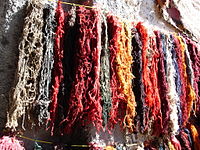
Photo from wikipedia
Abstract Mechanical responses of steel-and-synthetic-fiber-reinforced pipes (FRCPs) are discussed in this paper. The energy absorption, post-cracking strength (PCS), and toughness were analyzed based on the results obtained from the three-edge… Click to show full abstract
Abstract Mechanical responses of steel-and-synthetic-fiber-reinforced pipes (FRCPs) are discussed in this paper. The energy absorption, post-cracking strength (PCS), and toughness were analyzed based on the results obtained from the three-edge bearing (3EB) experimental tests conducted on the FRCPs in accordance with ASTM standard C497. A dry-mixed concrete material was used to manufacture the FRCPs, with variations in the fiber volume fractions (Vf): steel - 0.15%, 0.20%, 0.30%, and 0.40%; and synthetic - 0.15%, 0.20%, 0.30%, and, 0.40%. A total of 40 full-scaled tests were carried out on the synthetic FRCPs by incorporating different fiber volume fractions, and a total of 22 steel FRCPs full-scaled tests were conducted with the referenced fiber volume fractions. Based on the analyzed results from the 3EB tests, it was concluded that steel fiber reinforcement of concrete pipes shows higher energy absorption than synthetic one, and the increase of the steel and synthetic fiber volume fractions do not consistently improve the FRCP's load-carrying capacity. The ideal percentage of fiber for the highest load-carrying capacity is between 0.15% and 0.20% for dry-mixed concrete; however, the increase of the fiber volume fraction tends to increase the mechanical properties of toughness and PCS values. Based on 49.0% and 46.0% higher toughness and PCS values, respectively, it is concluded that steel fibers absorb energy more effectively than synthetic fibers when used as reinforcement. In addition, the steel-FRCP shows the higher ductility rather than the synthetic-FRCP in terms of the toughness index in accordance with ASTM C1018.
Journal Title: Structures
Year Published: 2019
Link to full text (if available)
Share on Social Media: Sign Up to like & get
recommendations!